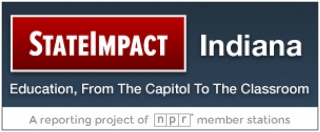
Julie Arnold is a fifth grade teacher in Carmel Clay Schools, and received one of the highest bonuses issued by the state this year, around $2,500. But many top-rated teachers received lower bonuses or nothing at all. The formula that calculates the bonuses is largely based on standardized test scores.
Claire McInerny/IPBHeather Peacock is part of a family of educators.
“Both my sister and sister-in-law are teachers,” she says.
The three of them teach in different school districts in the Indianapolis area: Zionsville, Perry Township, and Wayne Township, where Peacock works. Right before the holidays, they all received their state-issued bonuses for being good teachers.
“It was kind of fascinating, we were all together at Christmas, and I thought, OK, the three of us are all highly effective educators,” Peacock says. “While I didn’t begrudge any one of them for their, extra money coming on their check. I found it very interesting we had all been rated highly effective by our school administrators and we were all receiving different amounts of money.
One sister got a $2,200 bonus, the other got $900. Peacock received $47.
How Test Scores Affect The State’s Best Teachers
Each year, the state allocates millions of dollars in bonuses to Indiana’s highest rated teachers. But the don’t all get the same amount of money. This year, some got $2,500 dollars, and others $0. These allocations come from a formula, created by the legislature. It’s mainly based on test scores. So if most of a teacher’s students pass the ISTEP+, the teacher gets a higher bonus. If many students fail, that affects the teacher’s bonus.
This past year, ISTEP+ scores dropped across the state, so the bonuses were even smaller. And the teachers in school districts where families have more money, few students live in poverty, and most of them are native English speakers without special education needs, they received the most money.
Peacock received a $47 bonus, despite being rated highly effective by her principal and facing a lot of challenges in her classroom.
She taught at Wayne Township’s McClelland Elementary for 18 years. A third of her students are English language learners and around half of her class uses special education services.
These special learning plans require check-ins with parents and administrators, which means she spends a lot of time in meetings, doing paperwork, and creating substitute plans for when she’s meeting with a parent. Peacock is usually at McClelland Elementary from 6:30 a.m. to 4 p.m.- and most Sundays.
But because her students have various academic challenges, they didn’t have a high passing rate on the ISTEP+ last year. Which meant Peacock received one of the lowest bonuses (besides those who received nothing) in the state.
Peacock says, when teachers put in so much time and effort, a bonus helps their families afford a vacation or an opportunity to pad their savings.
“It could have really helped,” she says. “But my husband and I didn’t dwell. We have lots of friends where the shoe was on the other foot, so we were pleased for them.”
A great teacher, with a great bonus
At Carmel Clay Schools, 25 miles away, Superintendent Nick Wahl was not pleased when the bonuses came out.
“It was very sad to be quite frank,” he says.
In the current bonus formula, his highly effective teachers got the largest bonuses in the state, around $2,500. But he says the formula has to change.
“We have public school teachers across the state, from urban to suburban to rural, who are doing very good things in the classroom every day, and unfortunately it sent them a message that they’re not as important per se,” Wahl says. “I think that’s very unfortunate.”
Wahl says the state needs to value all of its top rated public school teachers equally – from Heather Peacock in Wayne Township to one of his highest rated teachers, Julie Arnold.
It’s obvious when you walk into her fifth grade gifted class at Forest Dale Elementary in Carmel, Arnold’s kids love learning. They gushed about a science experiment they did earlier in the day, and one of her students, Lily, explained what makes Arnold a good teacher.
“She gives us choices,” Lily says. “Some people learn a different way than others, and we’ll teach them in that way, and like she’ll let people group together and some work on their own. They each get to work in the way they want to.”
Like Peacock, when she goes home, Arnold plans lessons, does her paperwork and answers parent emails for 4-5 hours. She takes Saturdays off and works in her classroom on Sundays.
“I think of myself as a teacher for the whole child,” Arnold says. “So those things are necessary.”
Arnold says her bonus was helpful.
“That money was spent in the classroom long ago,” she says. “It gives you a bit of breathing room, to look at new tile, or a rug I had not intended to purchase.”
But while she got that breathing room, Arnold thinks the formula should change.
“I’ve never met a teacher who didn’t spend countless hours outside the classroom, who didn’t totally invest in what they were doing during the day, and at considerable sacrifice,” Arnold says.
A More Equitable Way To Give Teachers Bonuses?
Wayne Township Superintendent Jeff Butts says using test scores to calculate bonuses doesn’t recognize everything that teachers do.
“Is it about the impact that teacher has on that child from the time they walk into the classroom from the time they are no longer with that teacher,” Butts says. “Of course we would argue teacher performance is about that impact that teacher has on each one of those children.”
Butts, Wahl and other administrators around the state are asking lawmakers to change the formula. Many would rather see it based on student growth. So a teacher could get a bonus if students improve on testing throughout the year, regardless if they pass or not.
Lawmakers haven’t publicly committed to making a change, and haven’t filed any specific bills addressing the bonus formula. It could be added into the budget bill, which hasn’t been presented.
Even if the formula stays the same, both teachers say they don’t expect a bonus. And Wayne Township’s Peacock says she gets her validation from her students and their families.
“I’m not here for a bonus. I didn’t’ become a teacher to make piles of money,” Peacock says. “I love what I do.”
Peacock and many of her colleagues donated their $47 bonuses to their district’s education foundation, which gives teachers grants to try new things in the classroom. So far they’ve raised $4,000.
 DONATE
DONATE








 Support WFYI. We can't do it without you.
Support WFYI. We can't do it without you.